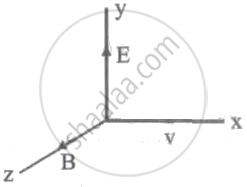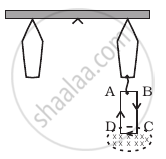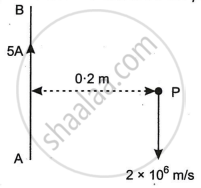Advertisements
Advertisements
Question
A solenoid 60 cm long and of radius 4.0 cm has 3 layers of windings of 300 turns each. A 2.0 cm long wire of mass 2.5 g lies inside the solenoid (near its centre) normal to its axis; both the wire and the axis of the solenoid are in the horizontal plane. The wire is connected through two leads parallel to the axis of the solenoid to an external battery which supplies a current of 6.0 A in the wire. What value of current (with appropriate sense of circulation) in the windings of the solenoid can support the weight of the wire? (g = 9.8 m s–2)
Solution
Length of the solenoid, L = 60 cm = 0.6 m
Radius of the solenoid, r = 4.0 cm = 0.04 m
It is given that there are 3 layers of windings of 300 turns each.
∴ Total number of turns, n = 3 × 300 = 900
Length of the wire, l = 2 cm = 0.02 m
Mass of the wire, m = 2.5 g = 2.5 × 10−3 kg
Current flowing through the wire, i = 6 A
Acceleration due to gravity, g = 9.8 m/s2
Magnetic field produced inside the solenoid,
B = `(μ_0"nI")/"L"`
Where,
μ0 = Permeability of free space = 4π × 10−7 T mA−1
I = Current flowing through the windings of the solenoid
Magnetic force is given by the relation,
F = Bil
= `(μ_0"nI")/"L" "il"`
Also, the force on the wire is equal to the weight of the wire.
∴ mg = `(μ_0"nIil")/"L"`
I = `"mgL"/(μ_0"nil")`
= `(2.5 xx 10^-3 xx 9.8 xx 0.6)/(4π xx 10^-7 xx 900 xx 0.02 xx 6)`
= 108 A
Hence, the current flowing through the solenoid is 108 A.
APPEARS IN
RELATED QUESTIONS
Magnetic lines of force always cross each other
Define one tesla using the expression for the magnetic force acting on a particle of charge q moving with velocity \[\vec{v}\] in a magnetic field \[\vec{B}\] .
An electron is moving with a speed of 3.2 × 107 m/s in a magnetic field of 6.00 × 10-4 T perpendicular to its path. What will be the radium of the path? What will be frequency and the energy in keV?
[Given: mass of electron = 9.1 × 10−31 kg, charge e = 1.6 × 10−19 C, 1 eV = 1.6 × 10−19 J]
A conductor has three segments; two straights of length L and a semicircular with radius R. It carries a current I What is the magnetic field B at point P?

A particle with charge q moves with a velocity v in a direction perpendicular to the directions of uniform electric and magnetic fields, E and B respectively, which are mutually perpendicular to each other. Which one of the following gives the condition for which the particle moves undeflected in its original trajectory?

An electron emitted by a heated cathode and accelerated through a potential difference of 2.0 kV, enters a region with uniform magnetic field of 0.15 T. Determine the trajectory of the electron if the field (a) is transverse to its initial velocity, (b) makes an angle of 30° with the initial velocity.
Lorentz Force generally refers to ______.
A charged particle of charge e and mass m is moving in an electric field E and magnetic field B. Construct dimensionless quantities and quantities of dimension [T]–1.
A 100 turn rectangular coil ABCD (in XY plane) is hung from one arm of a balance (Figure). A mass 500 g is added to the other arm to balance the weight of the coil. A current 4.9 A passes through the coil and a constant magnetic field of 0.2 T acting inward (in xz plane) is switched on such that only arm CD of length 1 cm lies in the field. How much additional mass ‘m’ must be added to regain the balance?

A long straight wire AB carries a current of 5A. P is a proton travelling with a velocity of 2 × 106 m/s, parallel to the wire, 0.2 m from it and in a direction opposite to the current, as shown in Figure below. Calculate the force which magnetic field of the current carrying conductor AB exerts on the proton.

